A Brand New Adventure
There are quite active discussions from time to time in forums on this website and others, about what really is an adventure in our modern age. Countries mentioned in this blog include Egypt, Libya and Syria.
Well, there are adventures going on in those places now, but sadly not of a nature to attract most users of this website. Many threads now comprise discussions on how at least two of these countries can be avoided, temporarily at least.
A contributor to one of the forums said, 'The concept of adventure, what it is, is all in the mind'. Which is exactly right I think.
Other contributors have pointed to celebrated travel and exploration books, citing various individual titles as the definition of adventure. So I'll mention here, The Worst Journey In The World, the account of an incredible adventure in the depths of the Antarctic winter, that commenced a hundred years ago tomorrow, 27th June 1911.
It lasted five weeks and was a part of Scotts second exploration of Antarctica. Wilson, Bowers and Cherry-Garrard hauled sledges laden down with everything needed to support life in that environment, across a deep-frozen and chaotic polar landscape, in continuous night time darkness, with not even a tent for shelter after it was ripped away in a blizzard. Miraculously they found it again after a few days wrapped around rocks and boulders. This adventure is usually overshadowed by Scotts fateful journey to the South Pole the following summer when he took Wilson and Bowers with him. None returned. Apsley Cherry-Garrard states in his preface to The Worst Journey, The writing of a book is an adventure, even if you dont think anyone is going to read it....... How true. And right now, ditto this blog.
Ive started a new adventure. It commenced back in February when I decided enough is enough, after a couple of months of the English winter I needed some sun, so booked a one-way ticket to the south of Spain. I thought maybe to stay over there until Easter, or until sufficient sunlight had returned to England to venture back. Before departure, one of those you never know whats round the corner events occurred, the start of maybe my biggest adventure yet. So here it is, on the eve of the hundredth anniversary of Cherry-Garrards great adventure in Antarctica.
I had to hurry back from Spain earlier than planned to deal with that round the corner incident. It led to many more journeys, hither and thither, a crescendo of unknowns and mysteries building up to the big one. That was back in the middle of May when I arrived at the final destination after all those expedition trips of the previous weeks. I felt like a tin of baked beans that had travelled through the bar code scanner half a dozen times, beeping and blipping and buzzing, before finally arriving on the other side of the checkout with the price revealed at last. Who would have thought that I would now need to reminisce a bunch of past motorcycle adventures, right in the middle of this most unknown of all adventures?
"Well, everything's clear!" Phew! That was good to hear.
"Except, on your bone scan, there's a strange hotspot."
"Here we go," I thought. "There's always a BUT!........"
The Doc expanded the image on the screen, a ghostly skull-and-crossbones apparition staring straight out into the room in the way that skulls and crossbones do. Menacingly. Except, that was me!
There was a strange and distinct black dot, right above the eerie, empty eye-socket. Like the beginnings of a real pirate eye-patch.
The Doc leaned towards me and tapped my own left eyebrow. "It's right here, in the bone. And its a bit rare. So we need to account for it. Old damage and injuries will show up on this scan, he continued. So have you ever had any trauma there?"
Well, where to begin!...... Trauma! What a sudden change of topic!....... How far back do you want to go? How long have you got?
It took a moment to get my thoughts straight. After paying intense attention to unknown future adventures, I suddenly had to grope around in the past. It was as though that tin of baked beans was travelling back through the checkout yet again.
"About twelve years ago. A motorbike crash. Hit the ground face down, slid quite fast head-first into the steel post of a road-side crash barrier. I remember that bit quite well. The usual slow-motion effect for a second or two, thinking I've a good helmet on, I must aim for the post head-on, otherwise I'll be squashed pretty violently under the hard edge of the barrier. That wont be good. My helmet was quite badly cracked. I have no other memory of the accident or what led up to it, so they diagnosed concussion and kept me in. Broke my hand in two places."
Ahh, thatll be it for sure, said the Doc.
And another one, I continued. Eighteen years ago, motorbike again. Havent the faintest idea what happened. No witnesses. I was found with my bike in a pile distributed around the base of a lampost up on the kerb. Unconscious for quite a few hours, no memory of anything for many hours before it happened. Dislocated shoulder, broken ankle, broken ribs. They brought me right here to this hospital. First class care, and helmet with a big crack in it.
OK, I think thatll explain it nicely.
Hold on, theres this as well. Forty years ago, another motorbike Im afraid. Locked my front brake at Braddan Bridge on the Isle of Man, slid a long way with both me and the bike hitting the edge of the kerb I think. It was the day before practice week started and I had the honour of being told at Nobles Hospital Youre the first in here this year! So at least something came out of it. Bike was OK and no bones broken.
Well, I think were safe to ignore this little dot then.....
Just remembered - around 1965 - no motorbike this time. I was day dreaming and walked into the road right in front of a car. You know, theyre such dangerous things those cars. But luckily for the driver there was a witness because I dont remember a thing from about three hours before to about five hours afterwards when I woke up in hospital. Dont know what part of me hit the tarmac but nothing broken. Wasnt wearing a helmet of course.
Right, that sews it up........
Wait! Theres more - 1963 - a bicycle this time - I was pedalling furiously downhill as you do at that age, but it was thick fog and at night - smacked straight into the back of a parked car and smashed my nose quite badly, needed an operation to put it back together. Dont remember what else hit the car other than the front wheel and my nose, but something else must have at that speed.
Thatll be en-..........
........ probably the last one, about three of four years old, playing in the street outside my grandparents house in central London (as children did in those days!) A neighbour found me unconscious on the pavement, he had to knock on a few doors to find out where I belonged. I still remember waking up in a stark hospital room with strange people, trapped in a steel cot, and all dark outside by then. The conclusion was, I either ran straight into a lampost or tripped up the kerb and hit my head on the pavement. No one saw it, Pimlico was a very quiet neighbourhood in those days.
Well, that one is probably too long ago to......
Its a bit strange isnt it? I interrupted. After all that, the little dot on my scan seems to be a bit on the small side, dont you think?
"Well, it's a place cancers hardly ever get to, including from the prostate. Very rare. So I think we can eliminate it from enquiries now.
Then it was back to the reality of the situation. A very high level of confidence that the tumour hasnt spread, and treatment started straightaway. Hormone juggling first, leading up to radiotherapy after three months.
At a later appointment to book the radio work (sounds like old times back in the telecoms industry) we reviewed all the scans again. Yes, were certain theres nothing on any of the scans that shows any spreading. But we can never rule out any microscopic spread. On the other hand, continued the Doc, you remember I estimated that this tumour started about twenty-five years ago. Well, seeing your account of past bone traumas, I think Im confident to say that the tumour in your prostate has found its such a dangerous world out there that it long ago decided never to venture out.
Thats fine, I said. But tell me this. Seeing your account of this hormone treatment, when I go to the swimming pool tomorrow for my usual session, should I enquire as to which changing room to use? Will they be able to give me a sensible answer? Noooo.... Should be no need for that! he replied. But if ever you find you can stop shaving in the mornings, maybe then will be the time to tactfully enquire. But dont worry, he continued, by the time the Olympic team selections start, youll still definitely qualify for the mens events, in one aspect at least.
.......... So a completely different sort of adventure continues for now. And writing about it is certainly an adventure in itself.
And would you believe it? The radiotherapy takes place in Guildford. The most direct route there is via a neat little network of muddy and sandy green lane byways between Leatherhead and Shere. So I hope HM The Bike will be well used during this episode - with no more bone traumas........
Moving on, theres not much in the way of photos you can use to illustrate the foregoing story. So for a different sort of adventure Ive transferred a few more pictures to the digital world from my visit to Antarctica.
And as announced in the earlier posting of 18th June, heres the most outrageous bit of parking Ive ever seen.
 Mr. Polar Parking Attendant, looking remarkably like one R. McCrankpin, prepares to slap an ice-encrusted parking ticket onto the windscreen of the good ship Captain Baker, registered as Kapitan Khlebnikov at the Russian DVLA. (In Cyrillic of course).
Mr. Polar Parking Attendant, looking remarkably like one R. McCrankpin, prepares to slap an ice-encrusted parking ticket onto the windscreen of the good ship Captain Baker, registered as Kapitan Khlebnikov at the Russian DVLA. (In Cyrillic of course).
 Windscreen? What windscreen? Where?
Windscreen? What windscreen? Where?
 The Meter Maids give up and build a snowman instead.
The Meter Maids give up and build a snowman instead.
 Reversing neatly out of the parking space. Honest Your Honour, there wasnt a single No Parking sign to be seen!
Reversing neatly out of the parking space. Honest Your Honour, there wasnt a single No Parking sign to be seen!
I made this trip in January 2000, on the Russian icebreaker Kapitan Khlebnikov, then chartered to the tourist industry after the collapse of the Soviet Union and its navy. A truly incredible journey from Tasmania, stopping off at many Australian and New Zealand sub-Antarctic islands on the way. Landings on the Antarctic continent followed at Cape Adare to visit Borchgrevink's 1899 hut (still in well-maintained condition) and the Italian research base at Terra Nova Bay, before arriving in McMurdo Sound and the U.S. base. This brought us to the southernmost point of sea navigation, 843 miles from the South Pole.
 All us passengers had free access to the bridge at all times. With the proviso, "Please don't fiddle with the main GPS, it's connected to the auto-pilot. We've fitted another one, to the right, for passengers to play with. The ship's radar is also available for your amusement whenever the crew aren't using it."
All us passengers had free access to the bridge at all times. With the proviso, "Please don't fiddle with the main GPS, it's connected to the auto-pilot. We've fitted another one, to the right, for passengers to play with. The ship's radar is also available for your amusement whenever the crew aren't using it."

The two helicopters on board took us on many excursions inland, including to Taylors Dry Valley in one of the worlds most extreme deserts. On the return, the ship moored up at Cape Royds and Cape Evans for visits to Shackletons 1907 hut and Scotts 1911 hut. Followed by a close approach to the Ross Ice Shelf, within about a hundred yards or so. But the planned helicopter landings onto the top of the shelf were abandoned owing to southerly blizzard winds blowing from the interior.
There were Yamaha Enduros on board as well that took us on a few landfalls, (which gives this posting a least a little relevance to this website.......)
 But I didn't think much of the choice of tyres for the local terrain.
But I didn't think much of the choice of tyres for the local terrain.
Some more photos:
A day or so out of Hobart, roughly where the Pacific meets the Southern Ocean, we moored up at Macquarie Island. An Australian World Heritage Site. Very appropriate as it seemed to be home to half the worlds population of seals and penguins.
 A popular beach. Popular with about 20,000 Royal Penguins. The photo doesnt convey the volume of the noise Im afraid.
A popular beach. Popular with about 20,000 Royal Penguins. The photo doesnt convey the volume of the noise Im afraid.
 The Khlebnikovs engine room was too vast to fit into one camera lens, this is a small part of one of six diesel engines......
The Khlebnikovs engine room was too vast to fit into one camera lens, this is a small part of one of six diesel engines......
 ...... and some essential spares - a couple of pistons, a shade larger than youd find inside any Yamaha.
...... and some essential spares - a couple of pistons, a shade larger than youd find inside any Yamaha.
Other than that, this engine room was just too huge to capture in a single picture.
Back out on deck, we headed south through the Ross Sea towards Ross Island, with Victoria Land on our right (sorry, starboard).
 Close to the tongue of the Campbell Glacier we took helicopter rides up and over it.
Close to the tongue of the Campbell Glacier we took helicopter rides up and over it.
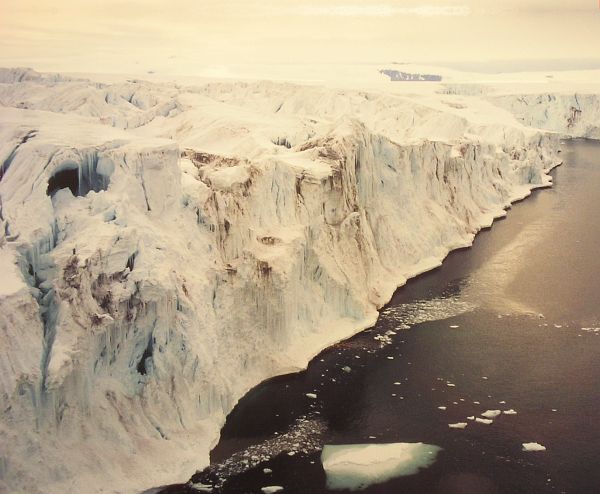 The view from above.
The view from above.
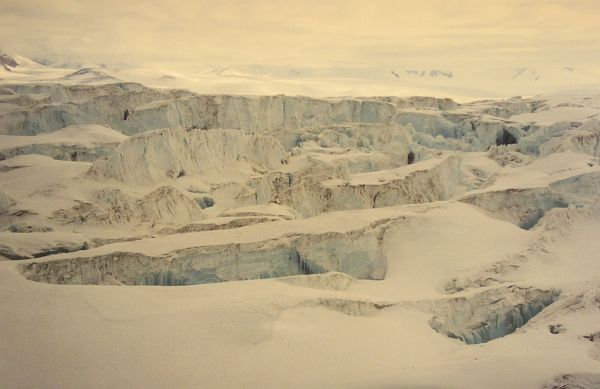 Cherry-Garrards expedition crossed a few glacier tongues on its way from Cape Evans to Cape Crozier, the entire length of Ross Island plus a bit. They would have negotiated terrain similar to this, with loaded sledges, in the dark, there and back.
Cherry-Garrards expedition crossed a few glacier tongues on its way from Cape Evans to Cape Crozier, the entire length of Ross Island plus a bit. They would have negotiated terrain similar to this, with loaded sledges, in the dark, there and back.
Ross Island came into view, enabling a pretty unique photo. Mt Erebus is an active volcano, ejecting a constant column of steam. Consequently in these climes, for around 90% of the time, its summit is shrouded in cloud.
 The temperature must have lifted on our summer arrival, and so did the cloud.
The temperature must have lifted on our summer arrival, and so did the cloud.
At the western end of Ross Island, where the Ross Sea is permanently frozen, the ship is parked up for helicopter access to McMurdo, Scott Base and Scotts Discovery expedition hut of 1901-04. The two helicopters ferry us all to Hut Point for a visit to the hut, and a climb up Observation Hill which overlooks it and the two research bases.
 Looking roughly northwest. In the distance are the mountains of Victoria Land.
Looking roughly northwest. In the distance are the mountains of Victoria Land.
The wide polished track on the left is the roadway access to the ice airstrip some way in the distance. The open water is a man-made turning pool, kept open by a US icebreaker, where supply ships moor up and manoeuvre.
Without a doubt, this is an expensive place for the K. Khlebnikov to park, even though its capable of cutting its own bay.
Scotts 1901 Discovery Hut
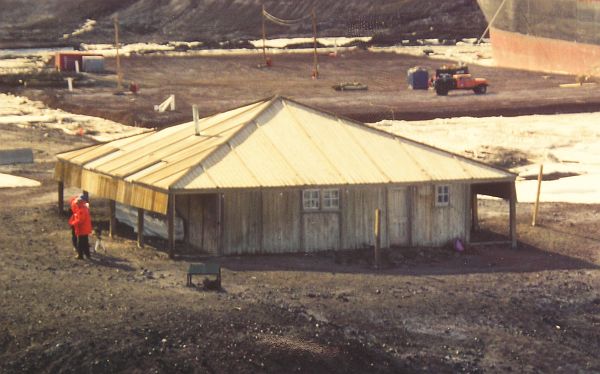 Built to last maybe 20 years, it still stands against the Antarctic weather, but needs much care and restoration work to do so.
Built to last maybe 20 years, it still stands against the Antarctic weather, but needs much care and restoration work to do so.
A small corner of the interior.

Through the helicopter window, about to land in the Taylor Dry Valley, west of Ross Island amongst the Royal Society mountain ranges.

 The Taylor Glacier flows into the Dry Valley. The extreme desert conditions result in none of this ice ever turning to liquid water. It evaporates straight into the atmosphere.
The Taylor Glacier flows into the Dry Valley. The extreme desert conditions result in none of this ice ever turning to liquid water. It evaporates straight into the atmosphere.
After departing McMurdo Sound we moored at Cape Royds to visit Shackletons Nimrod hut.
 A corner of the sleeping quarters. Reindeer skin sleeping bag, about a hundred years old, looks like its skin-side-outside-fur-side-inside.
A corner of the sleeping quarters. Reindeer skin sleeping bag, about a hundred years old, looks like its skin-side-outside-fur-side-inside.
(Yes, Beau has set Pontings little poem to music. But dont know how to transcribe music scores onto this website).
This tour had some wacky excursions on the agenda as well as lots of serious sight-seeing stuff. Firstly, a barbeque on the ice. Having found a firm-looking expanse of solid floating sea ice, on the way back north from McMurdo Sound, the K.K. was neatly parked.
 Red flags mark where passengers are allowed to go, and more importantly, not allowed to go.
Red flags mark where passengers are allowed to go, and more importantly, not allowed to go.
A few rows of tables were laid out, a couple of gas BBQs and everything was in full swing.

 (Rustus McC is 2nd back on the right hand side)
(Rustus McC is 2nd back on the right hand side)
But the ice had other ideas. Sat next to the parked ship, we munched on our burgers and lamb chops, and took photos, oblivious to everything around. The shadow of a crew member fell across the end of our table. Hi there! Everything OK with your meal? Warm enough? Now, theres no need to panic, please keep calm and wait till youre called. We have to interrupt the festivities. Immediately I call you, and not a moment before she continued earnestly, you must instantly get up and follow me precisely to the bottom of the gangway. Please, nobody step out of line!
 The ice had begun to crack. Inconveniently and quite seriously almost under our feet, with a few hundred fathoms of icy water right below.
The ice had begun to crack. Inconveniently and quite seriously almost under our feet, with a few hundred fathoms of icy water right below.
Whats more, it happened before our ice cream dessert was served!
 Against our threat of mutiny, we were hurriedly herded back to the gangway in strict single file as huge cracks and open water snaked towards our shuffling queue.
Against our threat of mutiny, we were hurriedly herded back to the gangway in strict single file as huge cracks and open water snaked towards our shuffling queue.
 Even a concerned penguin came along to wave us off of the disintegrating ice while the crew quickly craned all the tables and BBQ goodies back on deck.
Even a concerned penguin came along to wave us off of the disintegrating ice while the crew quickly craned all the tables and BBQ goodies back on deck.
 Growling cracks and leads of open water zigzagged towards our feet as we hurried onto the first steps of the gangway.
Growling cracks and leads of open water zigzagged towards our feet as we hurried onto the first steps of the gangway.
Everyone was safely counted back on board in good time. Panic didnt ensue.
And it wasnt only our ice cream afters that had to be cancelled. Plans to camp out that night in real polar tents on the ice were well and truly scuppered. OK, it wouldnt have been a real night, with twenty-four hour daylight, but thats not the point......
Further along the Victoria Land coast, a small group of Emperor Penguins had been discovered in a tiny inlet. There are strict rules on how close humans are allowed to approach wildlife specially in this sort of unusual situation. It was unusual because by now all Emperors had left the continent to live in the sea for a few months. We never expected to see any at this time of year.
 This group must have been unwell in some way, there were still traces of their winter coats on them.
This group must have been unwell in some way, there were still traces of their winter coats on them.
The Zodiac inflatable boats with their Yamaha Enduro engines brought us to the entrance of the inlet just sufficiently close to catch a glimpse.
Many of the huge icebergs that break off of the ice shelves have massive caves cut into them by a few years of wave action.

Inside these caves great icicles form, hanging from the ceilings, growing ever bigger from the spray from waves. Often, these icebergs become top heavy and turn turtle, and then slowly disintegrate.

Thus what were once massive icicles hanging from ceilings become pointed ice columns standing up on top of decaying slabs of old iceberg.

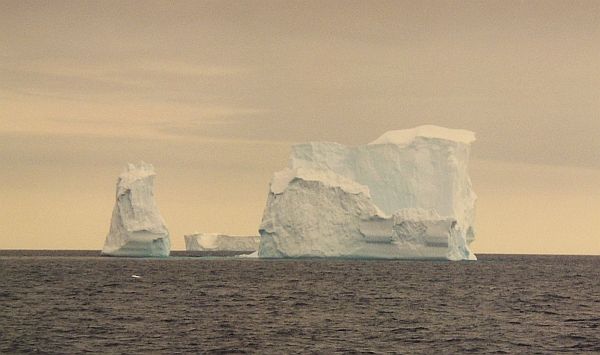 Another strange formation, the Stonehenge Iceberg.
Another strange formation, the Stonehenge Iceberg.
A helicopter-landing onto Sturge Island was on the itinerary, but weather intervened again. Instead, we crowded onto the bridge to watch the helmsman make as close an approach as possible to the ice cliffs in very murky conditions. It became quite hushed on the bridge as the ghostly white cliffs slowly filled all the windows.
 A few moments after I snapped this scene the helmsman steered us sharp left (oops, hard a'port) for a cruise close alongside the island's coastline.
A few moments after I snapped this scene the helmsman steered us sharp left (oops, hard a'port) for a cruise close alongside the island's coastline.
The Antarctic conditions might have stopped us helicoptering up onto the Ross Ice Shelf, and camping on the sea ice, but never mind, there were still crazy interludes on the menu to compensate. Near Cape Adare on the return sailing, we found a 20 mile by 15 mile iceberg that was nice and firmly grounded, and in the sunshine.
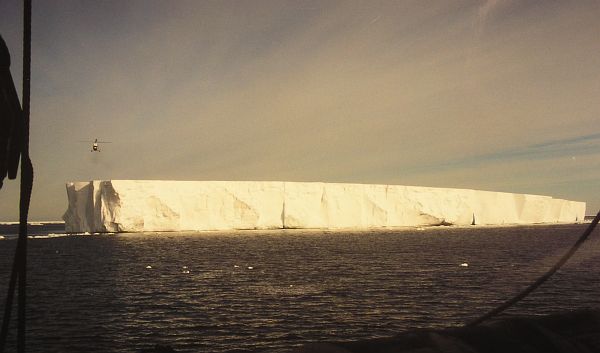
Some of the crew were lifted up onto it, with shovels and bottles, to build a bar out of blocks of snow. Before we knew it we were all flown in for an impromptu farewell party.
 Helicopter final approach.
Helicopter final approach.
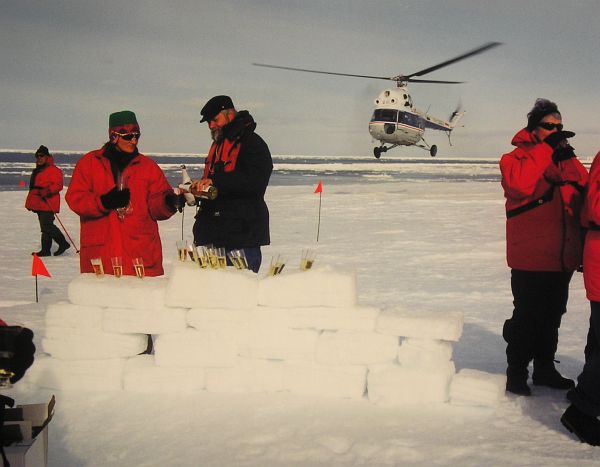 The dual-purpose ice bar and landing platform. We all hoped that this helicopter was bringing an ice bucket - it wasn't to be.
The dual-purpose ice bar and landing platform. We all hoped that this helicopter was bringing an ice bucket - it wasn't to be.
Being a proper iceberg, it had crevasses. This was a junior one. We were allowed to approach it carefully, lay prone on the ice, and wriggle the last short distance to peer right down inside it.
 There we could point our camera lenses straight down into the depths to get the obligatory photo.
There we could point our camera lenses straight down into the depths to get the obligatory photo.
I dont recall anyone attempting this after consuming too much champagne but the crew kept a very close eye on proceedings.
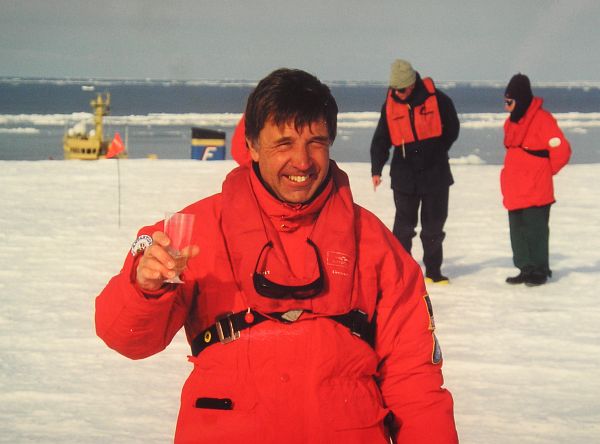 Final toast on departing the Ross Sea and its convivial iceberg.
Final toast on departing the Ross Sea and its convivial iceberg.
(Top of the ships mast and funnel just visible behind)
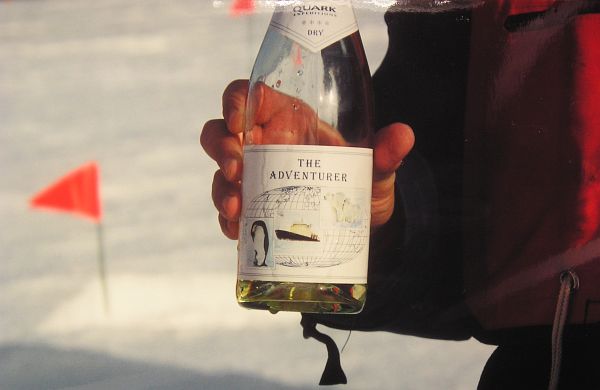 Very suitable choice of bubbly from the icebreakers extensive wine cellar.
Very suitable choice of bubbly from the icebreakers extensive wine cellar.
